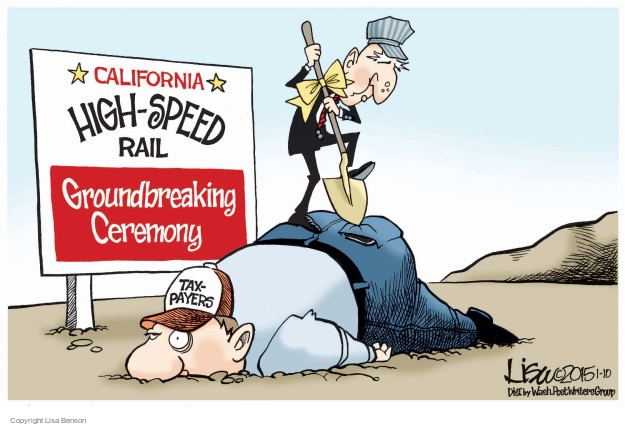
For years, the optimists have spun starry visions of millions of Californians traveling quickly, comfortably and environmentally consciously between the state's two major population centers. The pessimists, meanwhile, have grimly watched the projected costs mount. At last count, the estimates had traveled northward of $75 billion, and for all anyone could tell, were still climbing.
On Tuesday, during his first State of the State speech, Gov. Gavin Newsom (D) called for the state to scale back the project to a less costly leg that would run through the Central Valley — much simpler to build in large part because there are relatively few people there who might want to raise objections to the project, or, say, ride a high-speed train.
California voters can stop clutching their wallets. But voters elsewhere should pay close attention, because what happened in California illustrates the perils that face any U.S. rail project, or for that matter, any project at all that tries to meaningfully reshape U.S. infrastructure.
Almost anyone who travels abroad comes back wondering why every other country in the world seems to have cheap, speedy rail travel while Americans can barely go out for a cup of coffee without enduring either the tedium of an endless road-trip or the indignities of the TSA.
Sadly, there is no one reason; rather, there are many reasons, all of them hard-to-impossible to fix, all of them conspiring to deprive us of the (gee-whiz!) trains that many of us would like to ride.
Distance. In other places of the world, such as China, Europe and Japan, major population centers are much closer to each other. And big cities that are reasonably close together is pretty much a prerequisite for high-speed rail, which is why they have it and we don't. Imagine what it would take to build a line from New York City to Los Angeles — or to Chicago, Houston or Phoenix.
Wealth. Of course, the United States does have a few clusters that look ripe for rail, notably Texas, and the Eastern Seaboard. And instead of high-speed rail between these cities, we have the Acela, which takes eight hours to travel from Washington to Boston and shakes like a maraca player with a meth habit. Why haven't we built something better? Because truly high-speed rail needs to travel in a fairly straight line; you don't want to be taking a sharp curve at 300 miles per hour. Our current rail infrastructure isn't that straight where it needs to be.
Building newer, better, straighter rail lines would require the government to buy all the land between Point A and Point B and tear down anything that happened to be in the way. Because we're already really, really rich, what's between Point A and Point B is no longer farmland; instead we have a great deal of highly valuable real estate that will be very expensive to purchase — which we'd have to, because unlike China, our constitution gives the government limited ability to displace inconveniently located people.
Legal Proceduralism. Of course, Europe also has some pretty nice, and pretty pricey, stuff sitting between its cities. What Europe does not have, generally speaking, is the ability to tie up the government for a few decades in eminent domain appeals, environmental reviews and so forth. For historical reasons, the U.S. legal system offers citizens an unparalleled number of veto points at which they can attempt to block government projects. Any infrastructure project bigger than painting a schoolhouse thus has to either fight out the reviews and court cases for years, or buy off the opponents, or more likely, both.
Cost. U.S. infrastructure projects cost way more to build than they do everywhere else. The right likes to blame unions; the left likes to blame pricey consultants. But they're all arguing about the symptom rather than the disease. The reason U.S. transportation infrastructure costs so much is all the stuff I listed above, plus a healthy dose of federalism.
Read any essay bemoaning the cost of American infrastructure — say Brian Rosenthal's 2017 behemoth for the New York Times — and don't just gawk at the inflated numbers; ask yourself why U.S. infrastructure projects use so many consultants, so many union featherbedders and so on.
Answer: They are there to fend off future lawsuits, or to smooth compliance with some other level of government's regulatory bodies, or to appease some powerful lobby. And because these infrastructure projects involve so many different governments, none of whom has final authority over the project, there are a lot of lobbies that must be appeased.
Other countries have crony capitalism, of course, but the downside of our highly decentralized government, which pushes a lot of power down to smaller, more locally responsive governments, is that almost anyone can get a few cronies together and grab some politician's ear.
California displays all these pathologies with a vengeance. The part of the rail line that was reasonably cheap to build didn't go anywhere near where the people were; it ran through the Central Valley where land was reasonably cheap and the lobbies were relatively few. The parts of the line that were actually useful — the endpoints — promised endless legal and political headaches and astronomical costs.
And those two endpoints were 400 miles apart — too far, in the end, to be reached.
Every weekday JewishWorldReview.com publishes what many in the media and Washington consider "must-reading". Sign up for the daily JWR update. It's free. Just click here.
(COMMENT, BELOW)
Megan McArdle is a Washington Post columnist who writes on economics, business and public policy. She is the author of "The Up Side of Down." McArdle previously wrote for Newsweek-the Daily Beast, Bloomberg View,the Atlantic and the Economist.


 Contact The Editor
Contact The Editor
 Articles By This Author
Articles By This Author